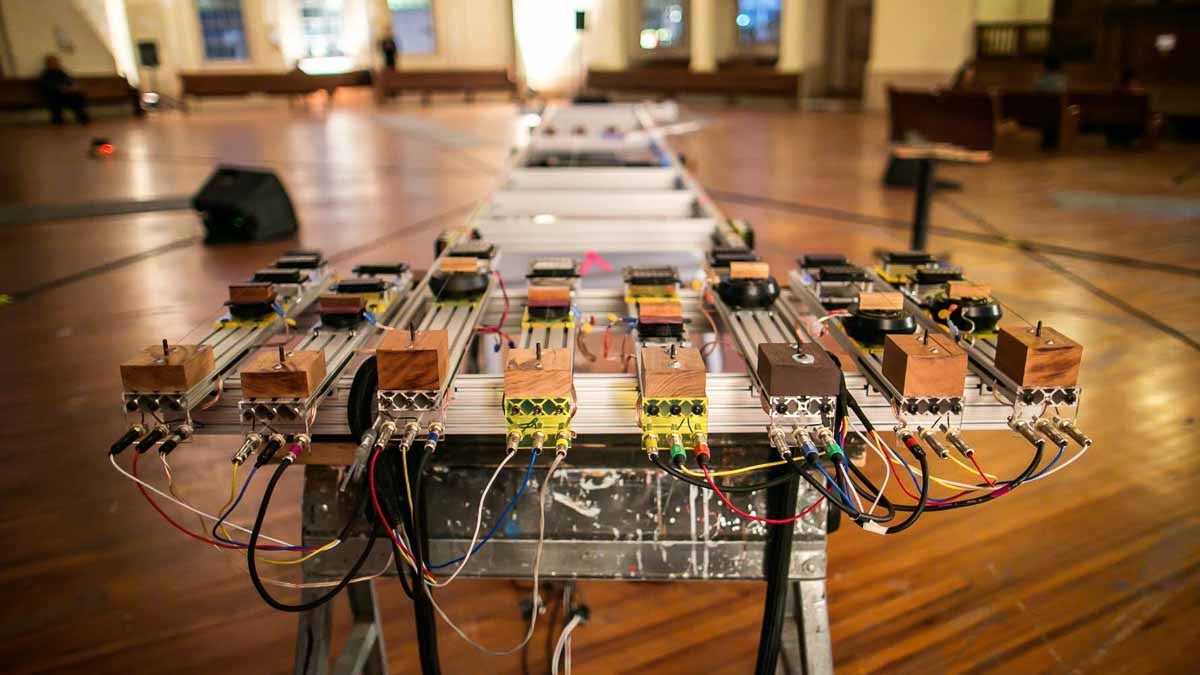How one composer’s hearing damage inspired a concert series
Listen
The Lady's Harp consists of pickups, transducers, and 20-foot strings. (Courtesy of Ben Tran)
In 2008, composer Daniel Fishkin’s ears started ringing, and they never stopped. Doctors offered no solace besides, “You get used to it.” In the absence of a medical cure, Fishkin vowed to find a creative solution.
“I do not want to get used to my hearing damage—I want to use it.”
Co-presented by Bowerbird, Composing the Tinnitus Suites: 2016 is a concert series that is Fishkin’s latest performance in an ongoing body of work that investigates the aesthetics of hearing damage.
Before the onset of tinnitus, Fishkin described himself as a “young punk rocker building instruments and trying in the most genuine way possible to present sincere creations of songs and weird sounds to the audience.”
He developed sound installations in freight elevators, performed as a soloist on modular synthesizer with the American Symphony Orchestra, and played innumerable basement punk shows.
Although his work shifted radically after his tinnitus diagnosis, Fishkin’s exploration of volume has remained constant. “What I find fascinating about volume was that it seemed like a way to create a whole experience, something that would envelop me or envelop the audience.”
A major turning point for Fishkin was an article about Texas sheriff Willie Morris, who committed suicide as a result of his tinnitus. “Morris specifically said in his suicide note that he hoped his death could bring awareness to the condition. I just was really moved because it was like everything I was doing in my life was not dealing with this problem of the tinnitus.”
Unable to comfortably make music in the rock band configurations to which he was accustomed, Fishkin began asking himself what tinnitus music might sound like.
Fishkin elaborates: “What is tinnitus music? is another way of saying “What is music where tinnitus isn’t ignored? What do we gain by listening to tinnitus? To make ‘tinnitus music’ is not just to compose sounds, but also to compose situations that can break the isolation of the experience of hearing damage.”
In an attempt to answer that question, Fishkin developed the Lady’s Harp—a system of 20-foot long piano wires activated by mixer feedback, using guitar pickups and pressure transducers to coax the strings into vibration. Fishkin was inspired in part by the Long String Instrument of venerable composer Ellen Fullman, who will join Fishkin in a duo performance on Sept. 30, 2016.
“I want to create a situation where my tinnitus matters, where my frame of listening doesn’t have to be subsumed by the background; where it can direct the music. If you’re hearing your tinnitus, you want to have a positive association with it. Now that I’m doing a project about tinnitus, when I hear my tinnitus, it’s like an old friend.”
This feature contains excerpts from Composing the Tinnitus Suites: 2015 by Daniel Fishkin, Cleek Schrey, and Ron Shalom.
WHYY is your source for fact-based, in-depth journalism and information. As a nonprofit organization, we rely on financial support from readers like you. Please give today.



